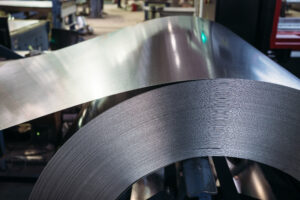Intro
Navigating the world of fabrication and manufacturing can be complex, with the choice of materials significantly impacting the performance and longevity of your parts. Among all of the options on the market, hot rolled and cold rolled steel are two of the most commonly used types. But what sets these two apart? When should you opt for one over the other?
In this guide, our expert machinists at Rapid Axis will delve into the unique attributes, benefits, and downsides of both hot rolled and cold rolled steel. We aim to help you make an informed decision for your next project based on the insights shared.
What Is Hot Rolled Steel?
Hot rolled steel is a type of steel that is processed at high temperatures, typically over 1700°F, which is above the steel’s recrystallization temperature. This process allows the steel to be easily shaped and formed while in a malleable state, making it ideal for producing larger sizes and shapes like sheets, beams, and rails.
As the steel cools, it hardens and strengthens, making it suitable for various construction and structural applications. The raw material goes through the hot rolling process before a machine shop works with the material.
Its surface is typically characterized by a rough, slightly scaly finish. At Rapid Axis, our expert machinists are well-versed in working with hot rolled steel, maximizing its benefits to suit your project needs.
Benefits of Hot Rolled Steel
Hot-rolled steel is a popular choice in construction and structural applications. We love it for its versatility and cost-effectiveness. The process of making hot rolled steel involves rolling the steel at high temperatures, which simplifies the process and reduces production costs.
This results in a more affordable product, ideal for large-scale projects where budget matters. Plus, the high temperature makes the steel easier to form and shape into various sizes and shapes, giving us more flexibility in fabrication.
Downsides of Hot Rolled Steel
Despite its benefits, hot-rolled steel has a few disadvantages. The high temperatures used in the process can lead to a less precise finish, meaning the steel’s dimensions might not be as exact as with cold rolled steel.
Also, hot rolled steel often has a scaly surface finish, which may require additional processing to achieve a smooth finish, depending on your project requirements.
What Is Cold Rolled Steel?

Cold rolled steel, on the other hand, is processed at room temperature. The process yields a steel product with closer dimensional tolerances and a wider range of surface finishes. If precision is crucial for your project, cold rolled steel is the go-to choice.
Benefits of Cold Rolled Steel
The cold rolling process creates a finished product that’s more dimensionally accurate than a hot-rolled product. This precision makes cold rolled steel a favorite for intricate and detailed projects. Additionally, cold rolled steel usually has a smooth, shiny finish — making it an aesthetically pleasing choice for visible components.
It’s also stronger and more durable than hot rolled steel, making it suitable for applications demanding high strength.
Downsides of Cold Rolled Steel
While cold rolled steel has many advantages, it’s not perfect. The cold rolling process is more complex, and the additional processing increases the overall cost of the steel. This makes it a less economical choice for large-scale projects. Also, it’s less malleable than hot rolled steel, meaning it might crack or break when bent.
Cold Rolled Steel vs. Hot Rolled Steel: What’s the Difference?
To put it simply, here are the differences between hot rolled and cold rolled steel:
- Processing Temperature: Hot rolled steel is processed at high temperatures while cold rolled steel is processed at room temperature. This difference is important because it influences the cost, malleability, and finish of the steel.
- Dimensional Precision: Cold rolled steel is more precise dimensionally than hot rolled steel. This is crucial for projects that require intricate detailing or high precision, as it ensures that each piece fits perfectly within the design specifications.
- Surface Finish: Hot rolled steel often has a scaly finish, while cold rolled steel usually has a smooth, shiny finish. This aspect is important for visible components, where aesthetics matter. Cold rolled steel’s superior finish usually eliminates the need for further finishing steps, saving time and money.
- Strength: Cold rolled steel is typically stronger than hot rolled steel. For projects requiring high strength and durability, this difference could be a deciding factor. This also plays into the longevity of your parts.
- Cost of the Raw Material: Hot rolled steel is generally less expensive than cold rolled steel. This difference is significant as it directly impacts the final cost of your project. Choosing hot rolled steel can lead to lower quoted prices from machine shops for fabrication — an advantage for any size project — with the cost savings becoming more substantial for larger projects.
- Malleability: Hot rolled steel is more malleable than cold rolled steel. This is key when your project involves forming and shaping the steel into specific sizes or shapes. The malleability of hot rolled steel can make the fabrication process easier and more versatile.
The choice between the two will depend on your project’s specific needs and requirements.
Conclusion
In the world of steel fabrication, the decision between hot rolled and cold rolled steel is critical. Understanding their differences, benefits, and downsides can help you make the right choice for your project. At Rapid Axis, we specialize in working with both types of steel, offering high-quality machining and fabrication services tailored to your needs. Whether you’re looking for cost-effectiveness or precision, we have the expertise to deliver. Get a free quote today.
